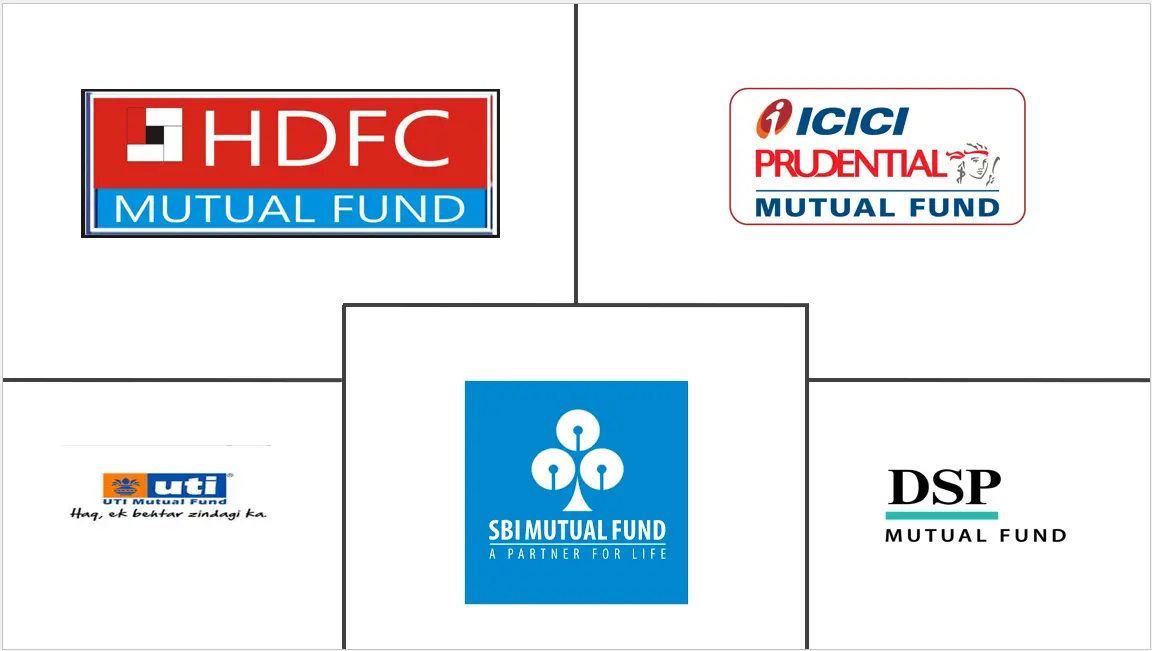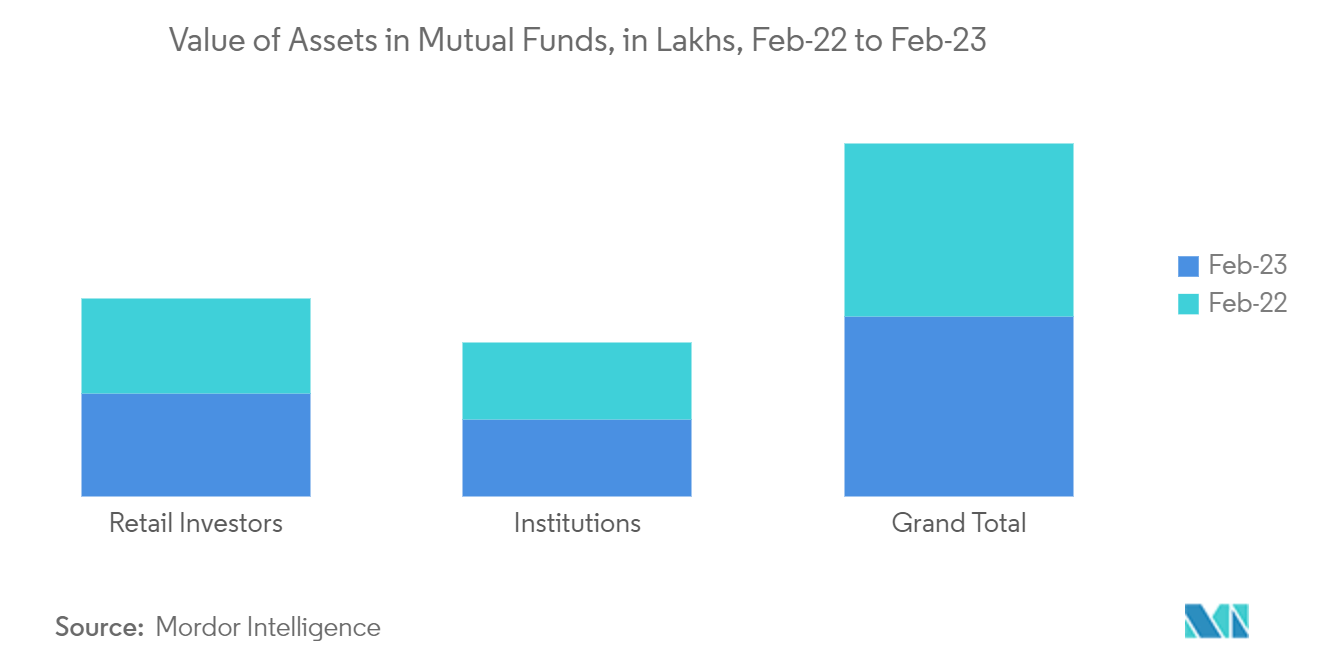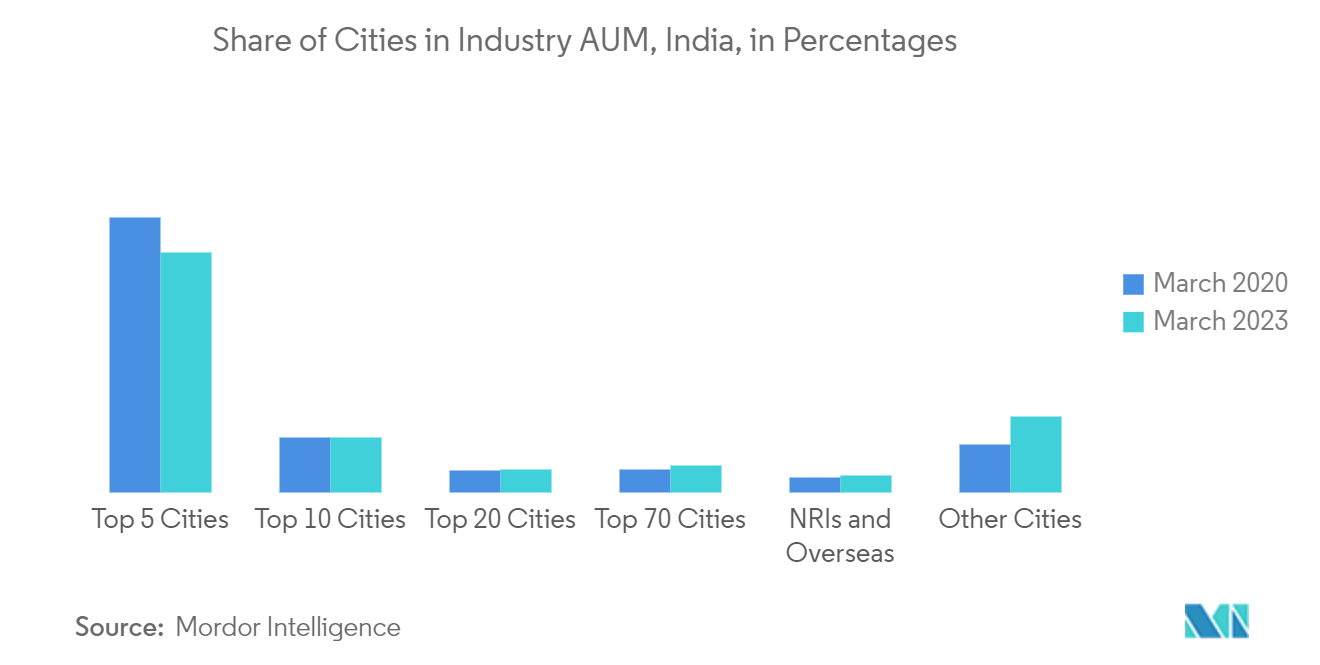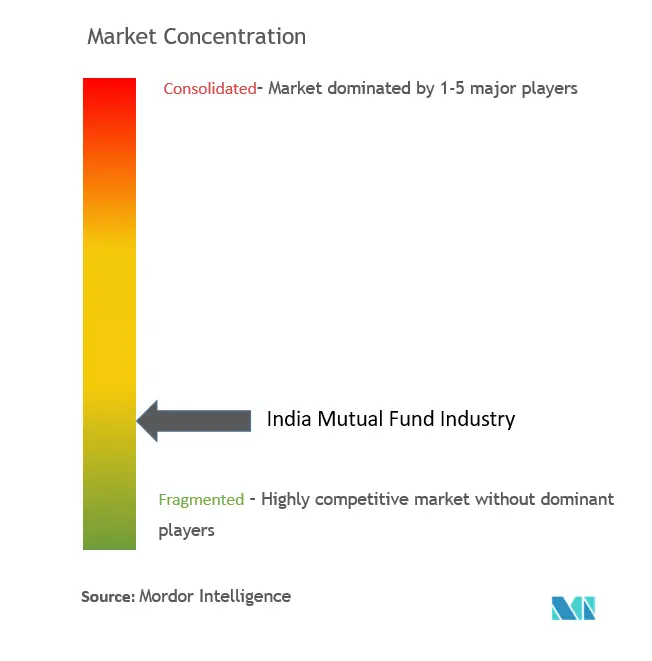India Mutual Fund Market Analysis
The India Mutual Fund Industry is expected to grow from USD 0.78 trillion in 2025 to USD 1.78 trillion by 2030, at a CAGR of greater than 18% during the forecast period (2025-2030).
Mutual Funds are a big part of India's financial services industry. They offer various investment options to retail investors and give institutional investors a low-risk opportunity to create new products or add flexibility to their portfolios. India's mutual fund industry is now the second-largest in the world. It's one of the fastest-growing markets in the world, with over 46 million households investing in Mutual Funds. There are over 40 fund houses in India, but the top 10 fund houses or AMCs manage more than 70% of the total mutual fund assets. The Indian mutual fund industry has seen a 5-fold growth in AUM over the last decade.
In recent years, the mutual fund industry in India has experienced a surge in growth. This is primarily attributed to the increasing population and wealth of the nation. Funds invested in mutual funds can provide income for those unable to work. This has increased the number of individuals willing to invest in mutual funds. Furthermore, the growing digital penetration, the emergence of smart cities, and the improvement in data speeds have also contributed to the shift of asset shares towards more diminutive towns and cities. The increase in retail contribution through Systematic Investment Plans (SIPs) indicates the level of digitalization in India.
The mutual fund AUM increased 77% post-Covid. While a large part of this increase can be attributed to the post-COVID bounce in the markets, it was also largely accounted for by fresh inflows into mutual funds. Furthermore, folios have also grown to provide a retail boost to the volumes. Given the macro mutual fund flow trends, this sub-trend doesn’t come as a surprise. The long-term and long-duration lock-in debt fund AUM increased significantly.
India Mutual Fund Market Trends
Hike in Mutual Fund Assets is Driving the Market
In addition to the asset base, retail investors' share of the industry's assets increased to 57 percent compared to 55 percent last January. Institutional investors make up 43 percent, of which corporates make up 96 percent. The rest are Indian and foreign institutions, as well as banks. Individual investors mostly stick to equity-oriented schemes, while institutions stick to liquid, debt-focused schemes, and ETFs and FFOs. in this route despite the volatility of the markets. Mutual fund SIP contributions have increased more than three-fold over the past seven years. Furthermore, the SIP book increased by 16 percent from the same time last year.
In addition to the asset base, retail investors' share of the industry's assets increased to 57 percent compared to 55 percent last January. Institutional investors make up 43 percent, of which corporates make up 96 percent. The rest are Indian and foreign institutions, as well as banks. Individual investors mostly stick to equity-oriented schemes, while institutions stick to liquid, debt-focused plans, ETFs, and FFOs.
Rising Share of Small Cities in Mutual Funds Assets Under Management is Driving the Market
The Sensex has gone up by a whopping 100% in the past three years, which has had a significant impact on investor behavior and how investors view stocks. At the same time, the number of demat CDSL and NSDL accounts has gone up by 2.85 times, the number of SIP accounts has doubled, and the average monthly SIP contribution in the mutual fund industry has gone up by 18%. But one of the most significant changes in the economy and India's saving habits has been the rise of small towns in terms of mutual fund assets under management (AUM). India's Association of Mutual Funds has classified these cities as 'Other cities,' a category not included in the country's top 110 cities (regarding industry AUM contribution). In the current year, these cities make up 17% of the total AUM in the industry.
India Mutual Fund Industry Overview
The Indian mutual funds industry is highly competitive, with major international players. The Indian mutual funds industry presents opportunities for growth during the forecast period, which is expected to drive market competition further. With a few players holding a significant share, the Indian mutual funds industry has an observable level of consolidation. The report profiles companies including HDFC Mutual Fund, ICICI Prudential Mutual Fund, SBI Mutual Fund, Aditya Birla Sun Life Mutual Fund, and UTI Mutual Fund, among others.
India Mutual Fund Market Leaders
-
HDFC Mutual Fund
-
ICICI Prudential Mutual Fund
-
SBI Mutual Fund
-
UTI Mutual Fund
-
DSP BlackRock Mutual Fund
- *Disclaimer: Major Players sorted in no particular order
India Mutual Fund Market News
- April 2023: ICICI Prudential Mutual Fund announced the launch of ICICI Prudential Innovation Fund. This open-ended thematic equity scheme will predominantly invest in equity, equity-related securities of companies, and units of global mutual funds/ETFs that can benefit from innovation strategies and themes.
- April 2023: HDFC Mutual Fund launched three index schemes – HDFC S&P BSE 500 Index Fund, HDFC NIFTY Midcap 150 Index Fund, and HDFC NIFTY Smallcap 250 Index Fund. These are open-ended schemes replicating/tracking the S&P BSE 500, NIFTY Midcap 150 Index, and NIFTY Smallcap 250 Index, respectively.
India Mutual Fund Industry Segmentation
Mutual funds are pooled investments from many investors to invest in various asset classes. A mutual fund can be a corporation's pension or an employee-owned company's savings plan, or an individual or family can manage it. The report explains the Indian mutual fund industry, regulatory environment, MF companies, and business models. The report also provides a detailed market segmentation with the product types, current market trends, changes in market dynamics, and growth opportunities. Furthermore, an in-depth analysis of the market size and forecasts for the various segments are presented. The Indian Mutual Fund Industry is segmented based on asset class, and source of funds. By asset class, the market is segmented into debt-oriented schemes, equity-oriented schemes, money market, ETFs, and foods. By source of funds,the market is segmented into banks, retail investors, Indian institutional investors, FIIs, insurance companies, and other sources. The market size and forecasts are provided in terms of value (USD) for all the above segments.
| By Asset Class/Scheme Type | Debt-oriented Schemes |
| Equity-oriented Schemes | |
| Money Market | |
| ETFs and FoFs | |
| By Source of Funds | Banks |
| Insurance Companies | |
| Retail Investors | |
| Indian Institutional Investors | |
| FIIs and FPIs | |
| Other Sources |
India Mutual Fund Industry Market Research Faqs
How big is the India Mutual Fund Industry?
The India Mutual Fund Industry size is expected to reach USD 0.78 trillion in 2025 and grow at a CAGR of greater than 18% to reach USD 1.78 trillion by 2030.
What is the current India Mutual Fund Industry size?
In 2025, the India Mutual Fund Industry size is expected to reach USD 0.78 trillion.
Who are the key players in India Mutual Fund Industry?
HDFC Mutual Fund, ICICI Prudential Mutual Fund, SBI Mutual Fund, UTI Mutual Fund and DSP BlackRock Mutual Fund are the major companies operating in the India Mutual Fund Industry.
What years does this India Mutual Fund Industry cover, and what was the market size in 2024?
In 2024, the India Mutual Fund Industry size was estimated at USD 0.64 trillion. The report covers the India Mutual Fund Industry historical market size for years: 2020, 2021, 2022, 2023 and 2024. The report also forecasts the India Mutual Fund Industry size for years: 2025, 2026, 2027, 2028, 2029 and 2030.
Our Best Selling Reports
India Mutual Fund Industry Industry Report
The integration of artificial intelligence (AI) in the food industry is revolutionizing the sector by enhancing efficiency, improving customer engagement, and ensuring food safety. AI's ability to analyze vast data is transforming supply chain management through predictive analytics, optimizing operations, and ensuring transparency. This technology excels in food sorting, quality control, and safety compliance, maintaining high hygiene and quality standards. Moreover, AI fosters personalized customer experiences by analyzing behavior and preferences, significantly benefiting the food processing segment through operation optimization and waste reduction. As AI's role in the food industry continues to grow, it drives innovation and efficiency across production, packaging, maintenance, and more, contributing to a sustainable and consumer-focused industry.
According to Mordor Intelligence™ Industry Reports, the AI in Food and Beverage market is experiencing substantial growth in share, size, and revenue, with detailed analysis and forecasts available in their free report PDF download. The industry analysis indicates a positive industry outlook with significant market growth. The industry research highlights the importance of market data and market segmentation in understanding the industry's dynamics. The market forecast predicts continued expansion, driven by market leaders and their innovative approaches. The market overview provides a comprehensive look at the industry's current state, while the market review and market predictions offer insights into future trends.
The report example showcases the detailed industry information and industry statistics necessary for informed decision-making. The industry reports and industry research underline the critical role of AI in driving industry sales and industry size. The market outlook and market value emphasize the economic impact of AI integration. The report PDF is a valuable resource for understanding market trends and market growth. Research companies can utilize this data to stay ahead in the competitive landscape. The industry trends and market segmentation provide a clear picture of the evolving market dynamics, ensuring stakeholders are well-informed about the market's future direction.







